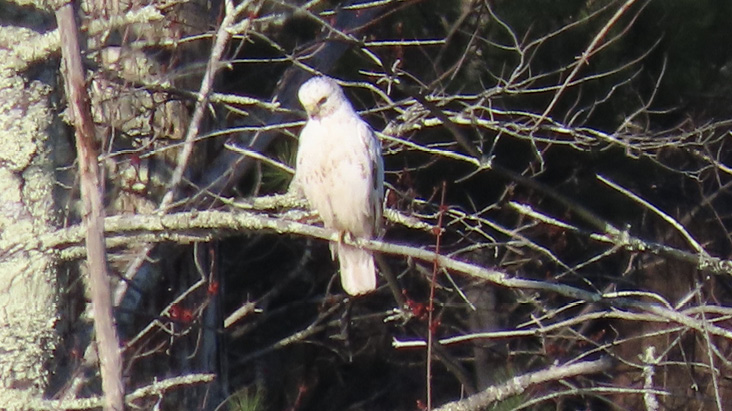Dan Furbish

Leucistic Red-tailed Hawk. Photograph by Beth Vacchino.
I bird a complex of cranberry bogs along Ring Road near the transfer station in Plympton, Massachusetts, several times a year. On November 22, 2019, I spotted a large, all white bird take off from a dead snag about 0.25 mile away. With powerful wingbeats, it flew over the corner of a bog pond, behind the pump house, and within 15 feet from the edge of the bog, passing a tree line. I caught only glimpses of it.
As the bird crossed Ring Road into another large bog, I noticed about two feathers on each upper wing that were dark, and I saw its light rufous gray upper tail with a darker subterminal band. I could not make out its patagial marks on its underwings. I originally thought it could have been a Snowy Owl, but with those field marks I knew it was a mostly leucistic Red-tailed Hawk. It flew into the tree line at the back of the bog. Many months later, on March 17, 2020, I finally got a photo that showed the hawk’s back and almost entirely white face and breast.
Over the course of six months, I went back to Ring Road and watched the area for 30–40 minutes, 24 times and saw the hawk—a female based on the large size—seven times. It is secretive in its movements. I have listed the sightings on eBird as “Ring Road near Transfer Station.”
On March 12, 2020, I saw a smaller, presumably male, normally plumaged Red-tailed Hawk nearby that the leucistic individual did not chase away.
I have been back to the Ring Road cranberry bogs six times since March 2020 and have not seen the leucistic individual, but I hope to see it again.
I asked fellow birder and fantastic wildlife photographer Beth Vacchino, who lives nearby, to be on the lookout for this outstandingly plumaged Red-tailed Hawk. Beth finally caught up with it—this photograph is hers.